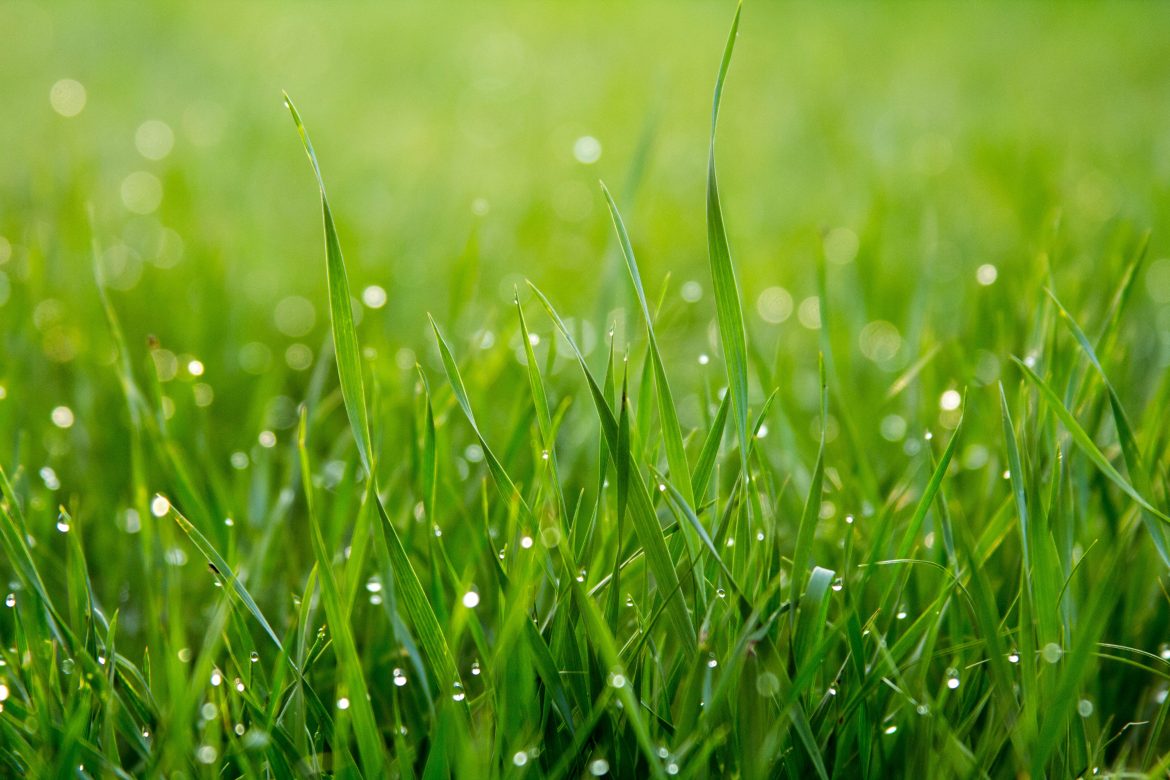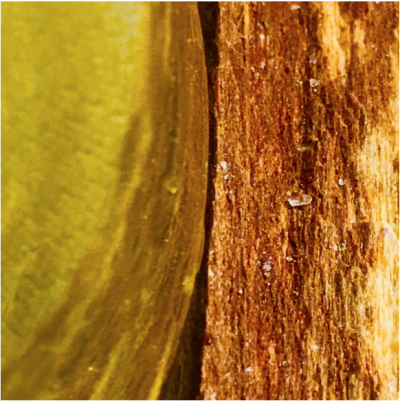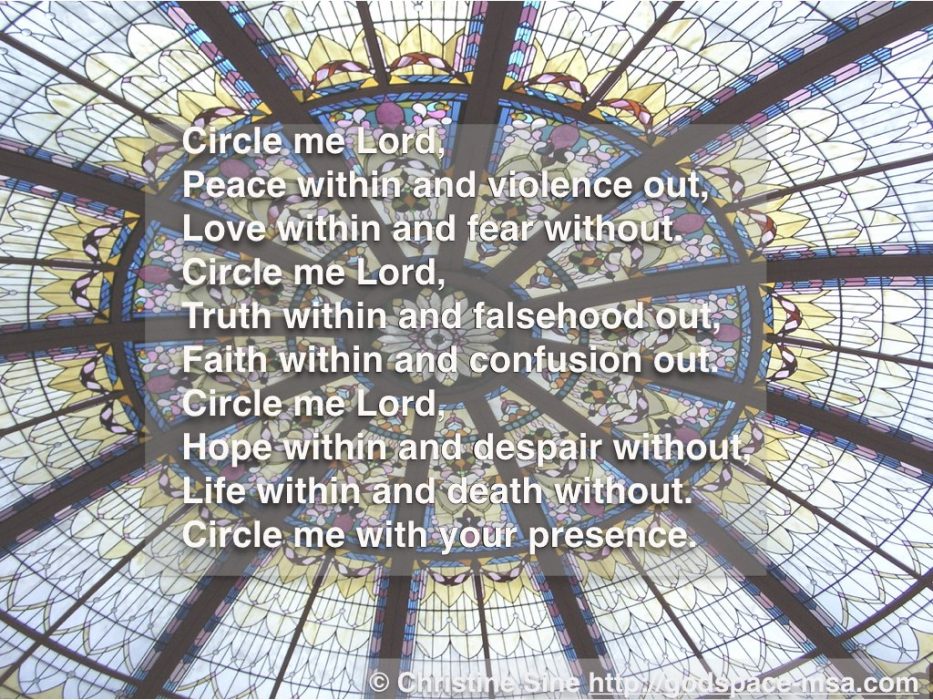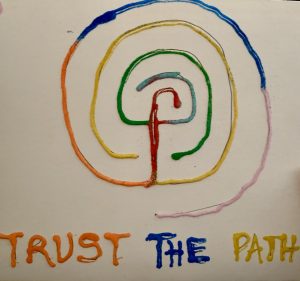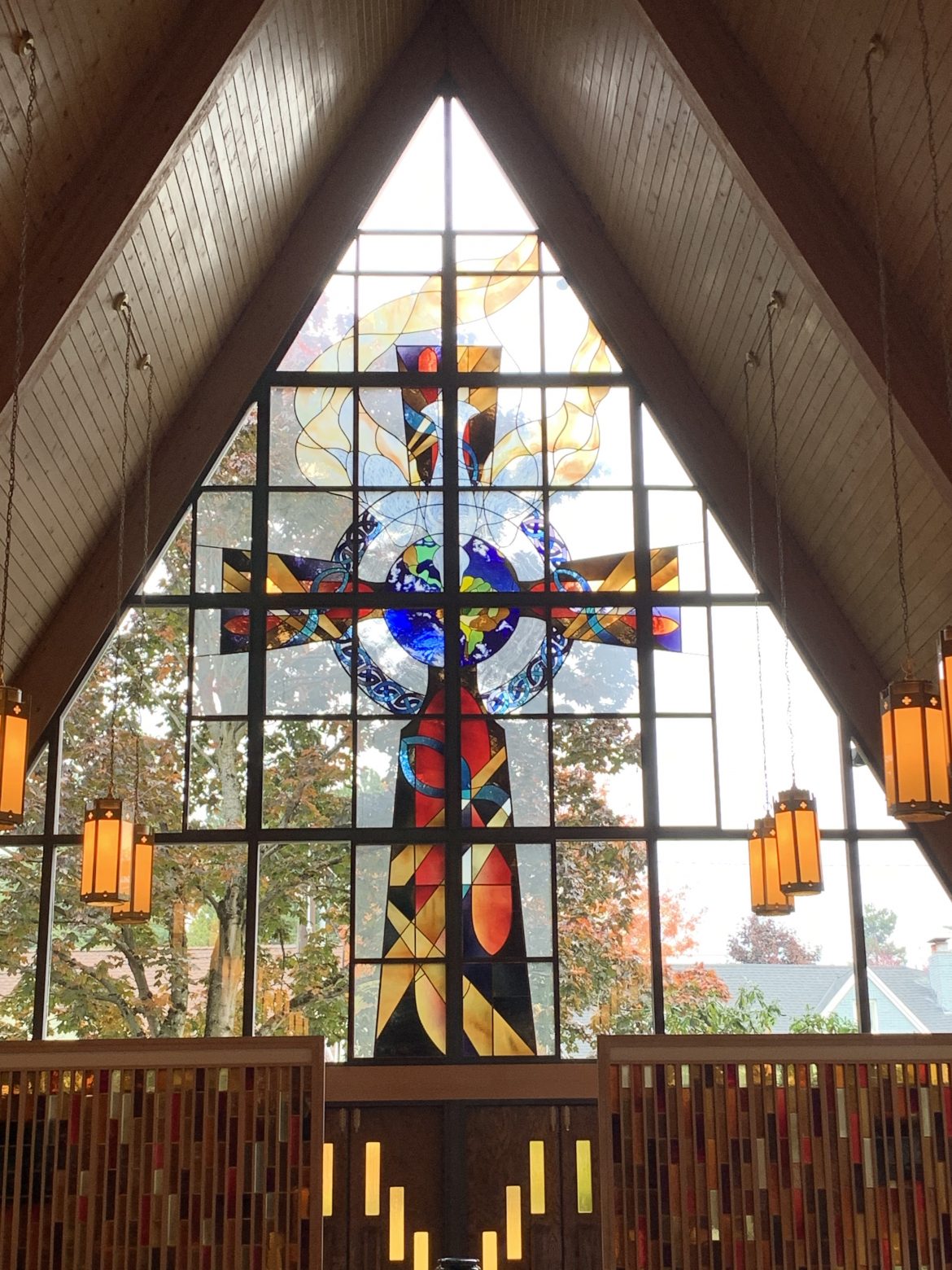by Lilly Lewin
This week I was honored to be a part of a global conference hosted by MovementDay. Normally this organization hosts an in-person gathering, but thanks to the pandemic, the entire conference went ONLINE. I was invited to lead some experiential worship/prayer practices since singing worship is hard to do together online. I also taught my workshop called “Curating Worship: An Introduction to Experiential Worship” online. Since the conference was about dreaming big for our cities and what we want to see in our cities in the next ten years, I redid one of my favorite prayer stations called “The Dream Jar” Station. I originally saw and prayed this station at the Greenbelt Festival years ago, and came home and added it to the prayer chapel at the National Youth Workers Convention. The original inspiration for this station came from the children’s book, The BFG by Roald Dahl, which I read out loud to my students in my teaching days. This shows that inspiration for prayer stations can come from so many places, like the Dollar Store (Pound Store), children’s books, TV shows, and, of course, The Bible!
So you are invited to pray this digital prayer station. You will need some paper and a pen and having your own empty jar would be great to have one, too! You and your family, roommates, or just you on your own can create a dream jar, or more than one, to keep praying with throughout this new season. Adding prayer dreams to the jar or jars as they come up! So today, DREAM BIG WITH JESUS! And pray using some paper, pen and an empty jar! Pause, Breathe deeply, and take 4- 5minutes to dream and pray!
Since most in-person conferences and retreats aren’t happening this year, my work is now all online. I’d love to help you think how to make your worship/prayer/conferences more interactive even via Zoom! So feel free to message me for more information! And check out freerangeworship.com and @lillylewin on Instagram.
©lillylewin and freerangeworship.com
I’ve been watching a series about revivals on https://commissionthecity.thinkific.com/ [I would highly recommend it]. But what has struck me is that when revival comes certain things happen:
- people stop going to pubs
- people stop going to sporting events
- people only want to go to church and pray
What I have noticed about this pandemic is the order things have reopened and the things everyone, including Christians, have seen as important.
- Our economy – which meant certain things had to reopen even before it was probably safe to do so and those things are:
- Firstly large sporting events that bring in lots of advertising revenue which are being watch at home on TV
- Second pubs, restaurants and cafés
- Shops, hairdressers, etc, etc
- And then lastly, our churches
My daughter works in hospitality. If she stops work to go and pray all the time, or has to stop because no one goes to the pub because they are all praying, how will she pay her rent? And she’s not the only one.
It made me wonder if this is why we are often reluctant to pray for revival, even if that reluctance might be only on a subconscious level. The pictures we are given is of the things we know and love – hospitality industry and sporting industry – grinding to a halt. Do we really want that? As we have seen with things being lockdown for a few months the country has tumbled into recession. Do we want that?
As much as these stories of revival are totally awesome, I think we need to be praying for a new picture to talk to us about revival. Someone did say to me that this pandemic and the lockdown have shown some key things – man’s fear of dying, the fragility of the economy but also our need for it, and also our individuality. Maybe our new picture for revival needs to be about tackling those issues rather than bringing down the economy and the industries that our country now survives on.
So don’t just pray “Revival” but ask God how it would look and how our families and friends would survive through it.
Three of the most beautiful lines:
‘He does not raise his voice;
He does not crush the weak,
or quench the smallest hope.’
So all our hopes,
though they might beat against our chest with wings,
or lie smaller than a mustard seed
hidden in the hand,
can grow in time
like the tall grass lengthening.
Can incline towards faith,
as seedlings seek out the light,
surpassing themselves
with the warmth of the sun,
and the wind
speaking over them.
Mary Oliver speaks of the Catbird,
‘common as the grass’,
who has picked his pond and made
a soft thicket of the world –
that in wonderment I consider
how good it really is
to be one of many,
in an ever stirring, breathing
mass of humanity.
Perhaps not so different
to a kingdom measured out in the grass,
from fence post to gate,
the breeze gently whispering,
the soft sun delivering a steady coverage.
Ana Lisa de Jong
Living Tree Poetry
February 2020
For more poems for Ana Lisa de Jong, check out the free downloads available in our store:
by Kate Kennington Steer, all images by Kate Kennington Steer
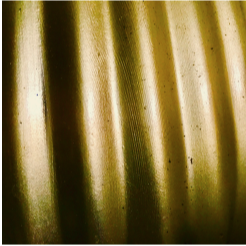
As a photographer and visual artist, I subconsciously take note of the level, type, angle, and colour of light throughout the day, month, season, year. Yet, in the past few months, I have been trying to be more attuned to my feelings about the changing light rhythms that make up different cycles. In particular, I’ve been paying attention to the Solstices, the Equinoxes and the cross-quarter days in between. This year, my feelings about the Autumn Equinox can be summed up in two words: ‘gathering’ and ‘gold’.
Somewhere in my psyche my English cultural heritage associates the end of September and beginning of October as ‘harvest festival’ season, even though the agrarian calendar might show that in fact cereal harvests are long over, and the next crop of winter wheat is ready to be sown. There are many traditional rituals around the cutting of the last sheaf, and its grain being used to make a communal loaf or sheaf of bread for the coming festivities when all the harvests – cereal, vegetable, fruit – are completed. And as I was thinking about the rhythm of cutting and sowing, I remembered being a child in Norfolk and seeing farmers burning the stubble in the fields.
 And suddenly, shockingly, I felt fear: have I been cut down? Have I been burnt utterly away? For a moment, my fear coalesced around the word ‘gather’: I have nothing to show for myself, there is nothing to gather, nothing to store, nothing to bring out in the coming long winter nights and reflect upon. And it occurred to me: perhaps the Autumn Equinox is the corrective festival a perfectionist most needs to celebrate? For, of course, when I ask myself, ‘what do you have to show for yourself? What do you have to share from yourself?’, below the shrieking fear, the deep-down answer comes back: lots.
And suddenly, shockingly, I felt fear: have I been cut down? Have I been burnt utterly away? For a moment, my fear coalesced around the word ‘gather’: I have nothing to show for myself, there is nothing to gather, nothing to store, nothing to bring out in the coming long winter nights and reflect upon. And it occurred to me: perhaps the Autumn Equinox is the corrective festival a perfectionist most needs to celebrate? For, of course, when I ask myself, ‘what do you have to show for yourself? What do you have to share from yourself?’, below the shrieking fear, the deep-down answer comes back: lots.
Lots of admittedly messy, unfinished, half-baked ideas, thoughts and projects; lots of acts of daily seeing, even if fewer of them than I would like were glimpsed through a camera lens; lots of words written, even if few of them are yet in a form that will make sense to anyone else; lots of doodles in sketchbooks that nobody has seen; lots of painted postcards that remain unsent. Much of this hoard needs sharing. Yet much of this hoard also needs ploughing back into my ground to form a rich enough humus for the next cycle of creation my Maker has in store for me.
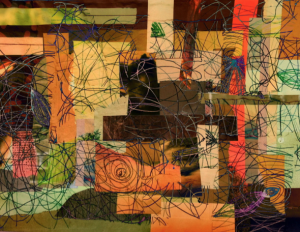 In his book, Spiritual Intelligence, Brian Draper cites Mark Greene’s term ‘small fruits’ to describe ‘small-scale change which can make a big difference to you and the world around you… It’s a way, perhaps, of taking stock and taking encouragement along your journey, of seeing what difference your journey is making.’ (41) The idea of micro-changes or ‘microshifts’ has become part of business management lexicon, but I continually find it a challenge to sustain them for very long. But something has been shifting, clarifying as I have watched the light lope across the ceiling of my bedroom these past few months: I have a very stark choice to make. Do I want to live a fear-filled life or a creativity-filled life? Which of these energies will take me across the next threshold of my becoming in a way which helps me flourish? Which of these energies do I need to gather to myself? Which of these energies do I want, need, to share with others?
In his book, Spiritual Intelligence, Brian Draper cites Mark Greene’s term ‘small fruits’ to describe ‘small-scale change which can make a big difference to you and the world around you… It’s a way, perhaps, of taking stock and taking encouragement along your journey, of seeing what difference your journey is making.’ (41) The idea of micro-changes or ‘microshifts’ has become part of business management lexicon, but I continually find it a challenge to sustain them for very long. But something has been shifting, clarifying as I have watched the light lope across the ceiling of my bedroom these past few months: I have a very stark choice to make. Do I want to live a fear-filled life or a creativity-filled life? Which of these energies will take me across the next threshold of my becoming in a way which helps me flourish? Which of these energies do I need to gather to myself? Which of these energies do I want, need, to share with others?
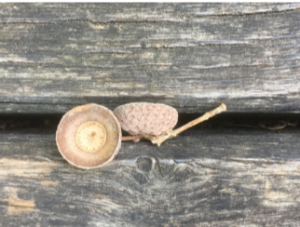 So my inner perfectionist needs to confront the language she uses. I am not cut down. I am not left behind, brittle, arid and useless. I am not left a mere husk of myself after the anxieties of COVID-19 lockdown, with no sense of an opportunity to rest before the potential onslaught of whatever unknown health crises this winter might bring. And the best counter I know to perfectionism is the redemption of gratitude: ‘I will gather you to joy’ says ‘the searcher’ in Rilke’s poem.
So my inner perfectionist needs to confront the language she uses. I am not cut down. I am not left behind, brittle, arid and useless. I am not left a mere husk of myself after the anxieties of COVID-19 lockdown, with no sense of an opportunity to rest before the potential onslaught of whatever unknown health crises this winter might bring. And the best counter I know to perfectionism is the redemption of gratitude: ‘I will gather you to joy’ says ‘the searcher’ in Rilke’s poem.
 I wrote a post on my blog imageintoikon in Lent reflecting on how often I need to remind myself to flex my ‘rejoicing muscles’, and I found that trying to increase my gratitude for what is present to me during the course of a day, week, month, season, year, is the key to this. My most regular gratitude practice focuses around making what I call ‘Grace Notes’ in my journal. But on the dark days I can only find a way to be truly thankful by digging beneath the surface stubble of my day, ’mining for gold’ as I go. ‘Mining for gold’ can sometimes be a rather arduous form of self-examination, and it reminds me of the hard, physical labour that is involved in ‘gleaning’ after a harvest.
I wrote a post on my blog imageintoikon in Lent reflecting on how often I need to remind myself to flex my ‘rejoicing muscles’, and I found that trying to increase my gratitude for what is present to me during the course of a day, week, month, season, year, is the key to this. My most regular gratitude practice focuses around making what I call ‘Grace Notes’ in my journal. But on the dark days I can only find a way to be truly thankful by digging beneath the surface stubble of my day, ’mining for gold’ as I go. ‘Mining for gold’ can sometimes be a rather arduous form of self-examination, and it reminds me of the hard, physical labour that is involved in ‘gleaning’ after a harvest.
In the Bible, the principle of ‘gleaning’ is first laid down in Leviticus 19:9 and Leviticus 23:22. God tells Moses that fields, vineyards and orchards are not to be harvested to the very edges or to the very tops of the trees and vines:
‘When you reap the harvest of your land, do not reap to the very edges of your field or gather the gleanings of your harvest. Leave them for the poor and for the foreigner residing among you. I am the Lord your God.’ (Leviticus 23:22 NIV)
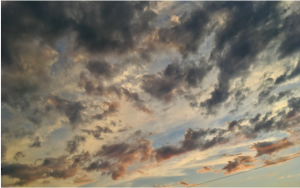 The principle of looking after others as being of equal importance to looking after oneself is thus deeply ingrained in the traditions of gleaning. So I wonder, as I look for all the golds the Autumn Equinox might bring me this year, what scraps of nutrition do I especially need to pay attention to? What do I need to gather to myself as encouragement or fuel or inspiration for the season after the Equinox? What gold can I share with others rather than hoard it to myself?
The principle of looking after others as being of equal importance to looking after oneself is thus deeply ingrained in the traditions of gleaning. So I wonder, as I look for all the golds the Autumn Equinox might bring me this year, what scraps of nutrition do I especially need to pay attention to? What do I need to gather to myself as encouragement or fuel or inspiration for the season after the Equinox? What gold can I share with others rather than hoard it to myself?
Ultimately, can my private, inner reflexive gratitude practice spill over into a microshift that could make a practical difference to someone else? Perhaps today’s literal equivalent of the Biblical principal of ‘gleaning’, in our city-centred, twenty-first century life, might be found in supporting ‘Food Bank’ charities? Perhaps the Anglican Church’s recent institution of making this time of year into a liturgical season called ‘Creation Time’ might suggest ways in which I can join in with a communal celebration of God’s gifts all around us, even whilst I am mostly home-based and solitary?
I am yet to answer any of these questions I pose to myself. But I know now what needs to characterise my celebrations of the Autumn Equinox this year: gathering, gleaning and gold.

by Christine Sine
This has been a hard week for me, probably the hardest since the pandemic began. The air quality in Seattle has been at hazardous levels much of the week, and though it is now only “poor” it is still enough for those of us who are sensitive to smoke, to feel the effects. Of course, others have had it much worse and I grieve with my friends in California and Oregon, many of whom have not only had to deal with the hazardous air but have also had to evacuate their homes. Some have lost their homes in the rapidly moving wildfires.
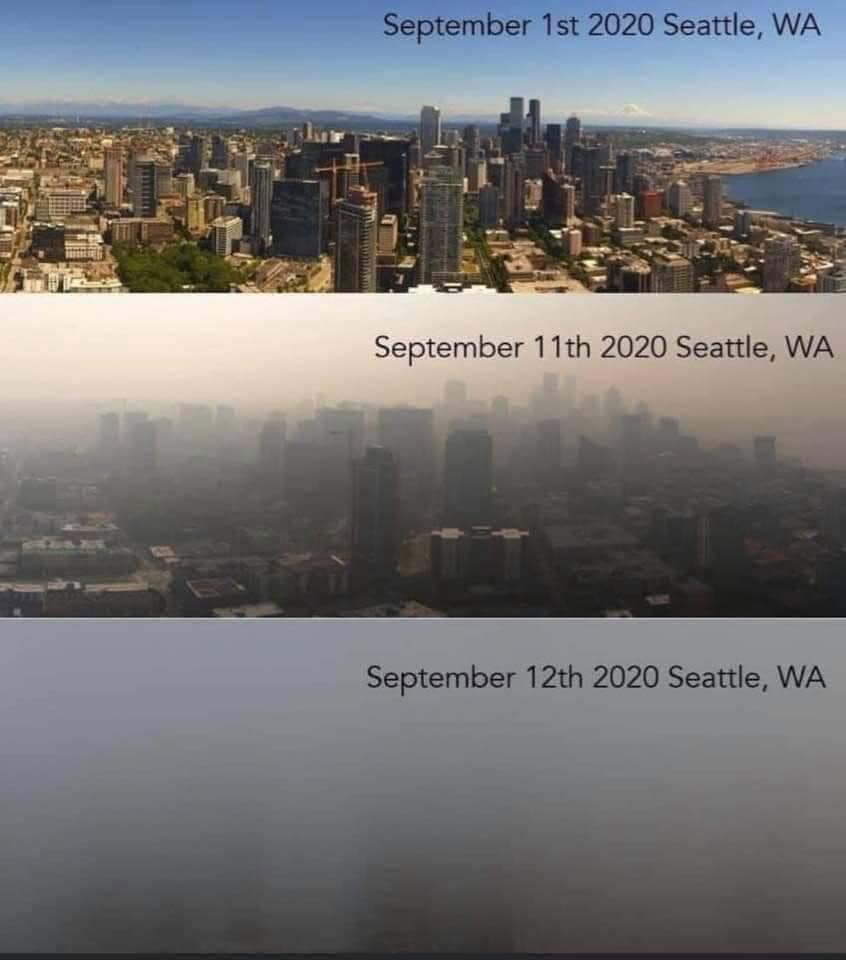
Seattle Skyline – photographer unknown
One interesting comment from a participant in the Wonder in the Trauma Healing Process webinar last Wednesday was recognizing the link between lament and wonder. Shortly after the session, I received an email from a participant commenting that Rabbi Abraham Heschel, one of the 20th century’s leading Jewish theologians and one of my heroes, emphasizes the need to begin and remain anchored in wonder in order to deal with the pain in the world. So, he felt I “was in very strong company”. Anchoring ourselves in wonder really does help us cope with the trauma of our world and that has certainly been my experience this week.
Wonder Changes Our Perspective on Life.
Wonder changes our perspective on life. It opens us to surprise, anticipation, unpredictability, celebration and mystery, replacing the rigidity of fear and anxiety with flexibility and joy. It enables us to imagine new life, new opportunities and the possibility of new beginnings definitely something that we all need to do at the present time. I think that one of the great benefits of wonder is that it helps us to look not at the pain but through the pain to God’s comforting and strengthening presence. It enables us to hold onto hope when everything around us seems hopeless.
Over the last six months, I have become an increasingly strong advocate for the power of wonder as a healing tool. Initially it was my awe and wonder walks – wandering the neighborhood with the wide-eyed wonder of a child- that has provided my greatest wonder inducing practice, but in the last few weeks, and especially this week as the air quality plummeted, I have found myself stretching for something more. The creation and use of my beach combing garden has enabled me to both delight and grieve. It has been one tool that has been a constant support for me. This week it has been my circling exercise that has provided my greatest stability. Each morning, I light my candles and feel the embracing presence of God around me, and then imagine it extending out to friends and neighbours, to strangers near and far, and radiating out to the whole world. Knowing that God embraces all creation is both awe inspiring and strengthening.
What I realize is that all of these are expressions of an embodied faith – not just praying with words but with our whole body and our actions as well. Incorporating our senses and our actions into our spiritual practices is awe inspiring. It helps us reach for the wholeness hidden deep within and brings us to a place of healing.
What Is Your Response?
Sit for a few minutes with your eyes closed and consider where you have found strength and stability this week. What has enabled you to maintain flexibility and resilience in the midst of our increasingly traumatic world? What new creative practices could help you not only connect to the wonder of God’s world, but also help you find healing and stability in the process?
Not Too Late to Join Us.
Wednesday, we will hold another Wonder in the Trauma Healing Process webinar. I hope that you can join us.
Wonder in the Trauma Healing Process with Christine Sine – 9/23/20
It is time once more for all of us too rest and take a Sabbath. I know that for many of us contemplative services like this one from St Andrews with Taizé style music become a wonderful focus for refreshing and renewing our spirits. This service for the Sixteenth Sunday after Pentecost does just that for us.
Carrie Grace Littauer, prayer leader, with music by Kester Limner and Andy Myers.
Permission to podcast/stream the music in this service obtained from One License with license #A-710-756 with additional notes below.
“‘La Ténèbre” (Our Darkness) and “Nada Te Turbe” – Copyright and all rights reserved by GIA/Les Presses de Taizé.
“Raboni, Beloved,” – By Kester Limner and Andy Myers, shared under the Creative Commons License, Attribution (CC-BY).
“Kyrie for September 20th” – Text and music by Kester Limner, shared under the Creative Commons License, Attribution (CC-BY).
“On Christ the Solid Rock,” – Public domain hymn, arrangement and additional verse by Kester Limner Shared under the Creative Commons License, Attribution (CC-BY)
by Lisa DeRosa
Home. What does that word mean to you? What feelings are elicited from its utterance?
Taking a small step outside, how about neighborhood? Are these feelings different? Maybe more distant? Or maybe community is a synonym for your thoughts about neighborhood?
Continue to extend this thought experiment out to city/town, region, country, continent, world, and universe. How connected do you feel as it broadens and the distance increases?
In thinking about where I currently live and my sense of place, this year has drawn me to really take notice of my surroundings. I left my place of work about a year and a half years ago, not knowing what God was going to provide next. After a journey of several months trying this job and that job, I began working for Christine and Tom starting in February this year. It is the shortest commute I could ever imagine because I live in their basement unit. So living where I do and working at home regardless of Covid, I have structured my day to include excursions out into the garden and plenty of walks around the neighborhood. In these walks, I witness the Black Lives Matter posters, the teddy bears in the windows, the vegetables that neighbors are growing, the kiddos that thank the garbage man every Thursday, the empty little free libraries… and I wonder to myself, how am I impacting my neighborhood? Or am I, even?
As the air quality has been particularly unhealthy over the last two weeks here in Seattle, I have not ventured outside much. Feeling the effects of the smoke in the air as well as the lack of fresh air, sunshine, and exercise, I feel as though I am disconnected from my place. Inside, home is still the same, but I haven’t walked around the neighborhood or nearby park, explored the garden to smell the flowers or pick raspberries for two weeks now. And I miss it.
With Covid restrictions and the fires taking over the West coast, I know others are struggling to find their sense of sanity through their normal coping mechanisms of walking outside, grabbing coffee with a friend, hosting a gathering in their home, etc. Others are having to evacuate their place without knowing if they will have anything to return to. That is the reality for so many right now and I pray for all those involved from the victims to the fire fighters.
In reflecting on your sense of place, where you are right now in this moment? Are you present? Do you feel connected to your surroundings?
This idea of place has been radically challenged for me in reading and listening to Dwight Friesen and Tom Sine talk about their newest book, 2020s Foresight: Three Vital Practices for Thriving in a Decade of Accelerating Change. A section in the book on reflecting on and knowing your place reads:
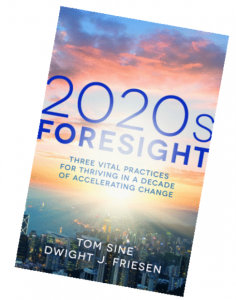
“You are not everywhere. You are somewhere. You may have moved many times or lived on the same plot of land your whole life. You are somewhere right now. There is a place you call home. Your place is God’s gift to you and those who share it with you. Your place is your teacher. Your place doesn’t force itself on you; it is the kind of teacher that whispers to you. It invites you to slow down and listen. It woos you to mindful attention to the impact of your foot-prints. It bids you to notice and seek communion with all its inhabitants. Place is the platform to discover the real. The primary thing place teaches, if we will listen, is faithful presence.” (2020s Foresight, 176-177)
The notion of slowing down and listening hit home during the first few months of our “stay home, stay safe” order. It forced me to schedule all plans as possibilities, stop traveling, and stay in my place. So I could really listen. So I could hear the sounds of the birds, not muffled by the sounds of traffic or planes overhead. To listen to the sound of the rain falling on the leaves in the garden. And listen to the sirens of first responders helping those in need.
Listening to, reflecting on, and knowing your place allows the opportunity for God to move not only in your heart and your home, but in your neighborhood as your sense of place extends outside of just your dwelling space.
I am grateful for Tom and Dwight sharing their insights with me as I have worked with them, but also that they share them in their book. The examples given are of real people, living in real places, who have reflected on and know the place God has them in as they seek to positively impact their neighborhood. How are you impacting your neighborhood? Or are you?
If you have thoughts about this, please comment. I am looking for creative ways to love the people in my place, too.
As an Amazon Associate, I receive a small amount for purchases made through appropriate links.
Thank you for supporting Godspace in this way.
When referencing or quoting Godspace Light, please be sure to include the Author (Christine Sine unless otherwise noted), the Title of the article or resource, the Source link where appropriate, and ©Godspacelight.com. Thank you!



